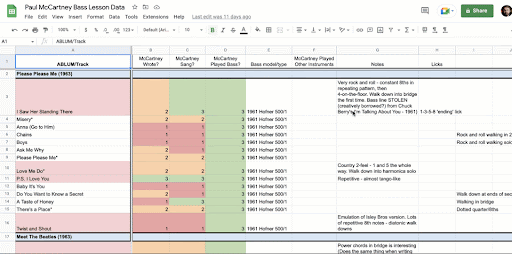I learned every 227 Beatles bass lines
That’s every song in the Beatles catalog (I think…).
It was a massive job trying to keep track of all these Paul McCartney bass lines, so I even made a super nerdy spreadsheet to keep track of everything:

The Beatles bass lines have a very special place in my heart since the very first line I ever learned was the iconic ‘Come Together’.
So I was super excited to start learning all the Paul McCartney bass lines.
But as I began learning the songs from the first few Beatles albums, I noticed something…
The lines on the early albums weren’t nearly as cool as Come Together.
And it wasn’t even close.
In fact, I found myself getting a little bored with the bass lines.
Not because the bass lines were ‘bad’ at all – the lines were fine, they worked great, and Paul played them really well.
But were they as melodic and singable as Come Together?
Definitely not.
That all changed on a dime though.
There’s one specific album where Paul McCartney’ss bass lines go from being a little dull, to being downright genius.
He started treating the bass in a completely new way and it transformed his playing into the bass legend that we know today.
So in this lesson, I want to show you what I discovered from learning the entire Beatles bass line catalog including:
- Why the early bass lines ‘worked’, but weren’t super compelling
- The extra ‘layer’ Paul added to his playing that let him churn out genius bass lines
- The reasons why his bass lines changed so much between one album and the next
- What Paul avoided doing that guaranteed his bass lines still worked with all the songs
Check out the lesson here:
Video Not Showing Up Here? Watch On YouTube
FREE - Download The Tabs And Tracks For Paul McCartney Bass Lines
Get the tabs, notation and practice tracks for these McCartney bass lines and start playing them - TODAY!
It’s one thing to hear these bass lines and listen to the difference between the early Paul McCartney bass lines and the later Beatles bass lines.
But you’ll truly understand the difference if you play these lines for yourself and experience the things I mention in the video.
So make sure you download the tabs and tracks for everything in this video.
Just fill out the form above and I’ll send it all to you – 100% free.
Good luck with the lesson and happy playing!
Cheers,




Yo! This is Deluxe! And it’s my birthday! As a long time guitar player playing bass now ( there are sooo many guitar players!), This fast track to ‘cant miss’ repertoire is fabulous!
Thanks again!!
Hi Luke…
I am Jae from the Philippines… I am a Bassist by profession… but as you might know here in my country a musician does not earn as much…so i had to do other jobs just to make ends meet…then i watch your YouTube video and thought this might be a blessing for me…i really love the Beatles and Sir Paul McCartney is my absolute favorite Bassist…and I would like to thank you for giving this lessons and tabs… really appreciate it…this would really make it much more easier for me to learn all my favorite Beatles songs
Hi Luke
Very interesting video, thanks for sharing
Minor comment hope it is private, since could sound like criticism but is rather a question/confirmation
The tab you show when you play the most iconic bass line of come together reports correctly two pick on the D (5th feet of the A string) in the video it looks you play it three times, also before the slide to the 12th. Am I wrong?
Cheers
Good eyes Repi – and you’re not wrong at all. In standard notation, if a note is held over a bar line (like is the case with Come Together) then that note is written multiple times, but with a tie to indicate that the note is still ringing out, but it is not played multiple times. Usually I delete these extra notes in the tabs since it can be a bit confusing if you can’t read notation, but in this case I must have missed it. My apologies, but I hope this makes sense.